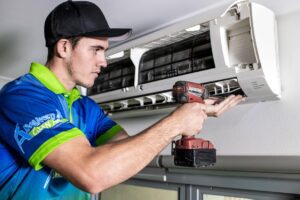If you’re a homeowner, deciding where to install your air conditioning unit is one of the most important decisions you’ll make. The reason is simple: Throughout the summer months, your AC will likely be running 24/7. If it’s not in the right spot in your home, you could end up wasting money and energy on an inefficient unit.
The best location for an AC unit depends on several factors like size of the home, number of windows and doors in the room, ceiling height and layout of rooms including furniture placement etc. So if you are planning to buy a new AC installation or want to upgrade the existing system then read this article carefully as we will cover all aspects related to choosing the best location for installing a cooling system in the house:
Keep the AC vents unobstructed
You want to make sure that any object placed near your air conditioning unit is not going to block or interfere with its ability to operate efficiently and effectively. This means keeping furniture and other items away from the vents, as well as keeping curtains or other objects that could obstruct airflow out of their way (and vice versa).
Don’t block the AC vent with plants or other objects. While these things may look nice in your home, they can negatively impact how well your system works by blocking airflow through its vents – leading to higher energy bills and lower performance over time!
The outside temperature will be an important factor in deciding where to place your air conditioning unit
You should place your air-conditioning unit in a shaded area. This will help keep the unit cool and prevent it from overheating. If you have trees or bushes around where you want to put your AC unit, consider moving them if necessary so that they’re not blocking the airflow from coming into or out of the vents on top of your HVAC system.
The best place for an air conditioner is one where there’s plenty of ventilation, the best scenario being open windows with cross breezes blowing through them! However, if this isn’t possible due to weather conditions (like extreme heat waves), then make sure there are no obstructions between where people are going into/out of houses/apartments with their windows closed all day long (i.e., furniture) and also check out local ordinances regarding distance requirements before installing one too close together).
If you have more than one room that needs cooling off, look into buying a multi-zone system so you can control each room separately
This is good for people who live in large houses or places with multiple rooms. You’ll also want to consider if there are rooms where the temperature doesn’t need to be adjusted as often as others like an office or bedroom and use those zones for less frequent cooling.
In addition to being able to adjust your AC unit through the remote control, it’s easy enough for others in your household (or even guests) to do so as well!
Place your A/C unit on a raised platform or table if possible so it is easier to reach and access when needed
- Make sure it is easily accessible.
- Place your A/C unit in a shaded area that gets at least six hours of direct sunlight per day (for rooftop units). This will help keep your energy bills down by preventing the unit from working too hard to cool down your home during hot weather.
- Choose an area that has good ventilation–not too close to windows or doors where there will be an influx of warm air into the room when they are opened for cross-ventilation purposes!
Keep the unit away from walls or other objects that may block ventilation
Make sure there are at least 18 inches of space between your air conditioner and any wall, window, door or other objects that could impede its operation. If you have an older model with a rear venting system, make sure this is not blocked by furniture or plants either.
Place your new unit at least 6 inches away from any furniture that might block airflow to it; this includes beds, chairs and dressers (and even people sitting on them). Just like with heating systems that rely on convection currents for heat distribution in a room such as baseboard heaters–you need to allow for plenty of air circulation around each individual component so they can do their jobs properly!
It pays to find the right spot for your air conditioner!
You may have heard the saying “location, location, location,” but in this case, we’re talking about finding the best spot for your air conditioner.
Your home’s climate can vary greatly from room to room. For example, a kitchen without proper ventilation will tend to be much warmer than other areas of the house and even warmer than it would be outside! So if you want your AC unit to work as efficiently as possible and keep everyone happy throughout the year (and not just during those brief moments when it rains), installing it correctly is crucial.
It pays off big when you put some thought into where exactly you’ll put your new AC unit before buying one or hiring someone else who knows how to get them installed properly too!

